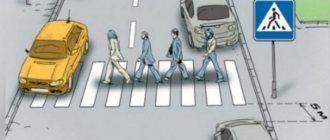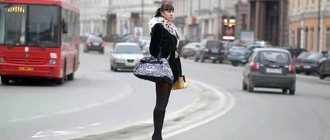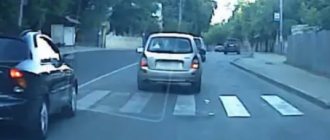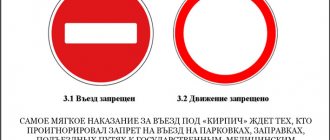In what cases and in what amount is a fine imposed on a motorist for a pedestrian? Road traffic involves two types of participants on the roadway - various vehicles and pedestrians. However, both of them, in order not to interfere with each other, must move according to certain rules. The legislation strictly monitors violators and provides for a fine for a pedestrian if a car does not allow him to cross the zebra crossing. However, the pedestrian is also punished if an accident occurs due to his fault.
Fine amount in 2021
By obstructing a person when he crosses the street at a zebra crossing, the driver may receive an administrative penalty. This is stipulated by current legislation. The fine for a driver who fails to let a pedestrian pass, depending on the specific circumstances of the case, can be 1,500–2,500 rubles.
Confirmation of the driver’s misconduct can be a recording of a traffic camera or an interview with witnesses. If the offense was recorded by a “safe city” camera or video recording from a police car, then it will be very difficult to prove your innocence.
Therefore, it is important to know in what cases you can receive a punishment.
Penalties are imposed on the driver in the following situations:
- when starting to move to a traffic light sign, when the pedestrian did not have time to completely cross the striped area;
- crossing a stop strip;
- obstructing the crossing of a blind pedestrian who signaled with a white stick;
- impossibility for passengers to board or exit public transport;
- obstructing a pedestrian when turning a car to the right;
- failure by the driver to recognize the priority of a pedestrian in a residential area.
Such incidents result in administrative liability for the driver. If a driver overtakes on lined lanes, the law provides for tougher penalties. This violation of traffic regulations is punishable by a fine of 5 thousand rubles or confiscation of the driver’s license for six months.
The fine for stopping at a zebra crossing has been in effect for several years now, and in 2018 it remains at the same level. Such a violation will cost the car owner 1,000 rubles, but this figure is not common in all regions of the country. The same violation in Moscow or the Northern capital of Russia raises the price of punishment exactly three times.
Why are pedestrians fined?
It is important to know! Traffic participants are responsible for any violations. If a person is caught failing to comply with traffic rules, the penalty amount is up to 500 rubles.
This is relevant for minor deviations from the norm, including those that do not create a direct threat to traffic rules. Good reasons for financial punishment include:
- Transition to a red traffic light;
- Moving directly along the roadway;
- Staying in an area marked with a “no pedestrian traffic” sign;
- Walking in front of an emergency vehicle (provided the vehicle has working light or sound signals);
- Creating obstacles to the full movement of cars or other pedestrians.
Unfortunately, it can be very difficult to bring the culprit to justice, even if his actions were recorded by a registrar or other special means. In addition, fines for pedestrians are low, so most repeat the offense after paying.
Amount of penalty
The question of how much is the fine for jaywalking in 2021 is relevant due to the fact that the requested amounts change regularly. The minimum cost of non-compliance with traffic rules is 500 rubles. For more serious violations, the size of the sanction increases to 1000-1500.
Such penalties are prescribed for pedestrians who are responsible for causing accidents with injuries.
Many believe that citizens are being punished without reason. However, an administrative offense in the form of crossing the road in the wrong place can cause extremely serious consequences. Therefore, a fine for non-compliance with the law is a completely acceptable measure.
How do you pay
To pay off the fine, citizens should use one of several proposed methods. But first you need to make sure that the amount is clearly defined and an appropriate decision has been made.
You can make a payment in the following ways:
- Through the cash desk of Sberbank;
- Via a payment terminal;
- Using an online banking service;
- At traffic police offices;
Receiving a discount
You can reduce the fine for a pedestrian for jaywalking in 2019 by using the State Services website. However, this method only applies if payment is made no later than 20 days from the date of registration of the violation. If this deadline is not met, the full cost of collection will have to be reimbursed.
How to find out about a fine
It is not difficult to carry out such a check. This can be done in all branches or on the traffic police website. A similar procedure is carried out through the Sberbank Online resource. Those who don’t know where to look up a fine for a pedestrian for jaywalking should also pay attention to the State Services service.
Using these methods, every citizen has the opportunity to find out the existence of a material sanction. Here you can make a payment or find out if there is any debt.
The concept of “pedestrian crossing” in the new edition of the traffic rules
A pedestrian crossing is a section of the roadway that is intended for the movement of people across the roadway.
Such areas are indicated by “Road Crossing” road signs or special striped markings. Joint markings are often used to improve the marking of a given area. Signs provide an opportunity for a person to maneuver to the other side of the street without interfering with traffic, and vice versa.
This index comes in two varieties:
- The pedestrian moves from right to left.
- He also moves from left to right.
A driver who fails to yield to a pedestrian is subject to a monetary penalty. Of course, traffic rules severely punish careless drivers, and the law is often on the side of others. However, video recording of the violation will allow you to appeal the punishment to the courts. You just need to understand what modern transitions look like and their characteristics. This will allow us to look at this offense a little differently.
Pedestrian sections for crossing the roadway have the following types:
- underground;
- overhead crossings;
- regulated by traffic lights;
- unregulated intersections.
Of course, the first two types do not cause any problems for participants in the road process - the sections bypass the roadbed from below and from above. A highway or intersection controlled by traffic lights is more dangerous to cross than the above settings. But if traffic rules are followed by both cars and people, there will be no danger. Even if you accidentally cross a red traffic light, the driver must use every opportunity to prevent a collision with a person.
The most dangerous crossings are unregulated crossings. However, the new traffic regulations state that crossing should not force a person to change their direction or speed. In other words, the pedestrian should not return to the sidewalk if he has already stepped on the zebra crossing. This case obliges the driver to give priority to the pedestrian. It goes without saying that an area with a non-working traffic light is automatically equated to an unregulated one.
In order not to commit an offense, the car must stop in front of the zebra crossing even before the moment when the person puts his foot on it.
It is allowed to continue driving only after reaching the other side of the street. Financial liability is provided for those who like to overtake in an area intended for the passage of people. This penalty appeared last year and provides for a fine, even if the transitional “bar code” is clear of pedestrians.
The legislation guarantees a person a free transition also in the following situations:
- The transition occurs when a vehicle comes around the bend.
- People are crossing the road in the adjacent area when a car drives into it.
- A similar situation, but with a car leaving.
- If a person is holding a white cane, that means he is “blind.”
- When people move to a public transport stop or return to the sidewalk.
Of course, the easiest way for a traffic police officer to put a driver in an awkward position is in an area where there are markings. However, this does not mean that every incident of not allowing a person to pass may result in a fine.
Perhaps there will be good reasons that will confirm the driver’s innocence. But repeated commission of an offense is punishable more severely than the fine above.
Penalties provided for pedestrians in 2021
The new rules provide more precise definitions of a pedestrian crossing, prohibit cyclists from riding on it, and prohibit overtaking in a pedestrian crossing.
Let's take a closer look at each change:
- From now on, a pedestrian is not only the one who is at the zebra crossing, but also the one who crosses the road on the highway outside the special markings.
- Previously, drivers did not have the right to overtake at a pedestrian crossing if there were people on it (clause 14.1). Now there is a strict ban on overtaking, and it doesn’t matter whether a person crosses the road at this time or not.
- According to the new rules, the driver is obliged to let a pedestrian pass in any situation, even if he has one foot on the crossing.
- You drive up to the zebra crossing and see that a person is already walking along the crossing. In this case, you must skip it (clause 14.1).
- If the car driving in front of you has slowed down to allow a pedestrian to pass, you must also brake (paragraph 14.2). Overtaking in a pedestrian crossing and driving into oncoming traffic are serious violations and may result in your driving license being revoked. Moreover, an accident may occur.
- If at the traffic light the driver's permission signal is on, but pedestrians have not yet crossed the road, then you must wait until they finish moving and only then drive (clause 14.3).
- According to paragraphs 14.5, 14.6, 14.7, pedestrians should be allowed to pass in the following cases:
Clause 8.3 states that if a driver leaves the adjacent territory onto a road, he must give way to all cars and pedestrians on it. If the driver enters the adjacent territory, then he should give way to cyclists and pedestrians, whom he may interfere with his movement.
If the pedestrian has not yet started moving along the zebra crossing, but is just getting ready, then the driver should not stop and yield to him. A new commentary for 2021 regarding the definition of “Give way to a pedestrian” will help you understand this issue.
Let's assume that the driver did not allow the pedestrian to pass, who himself caused the accident. You can prove your non-involvement using the following algorithm:
- Wait for the inspector to show his ID and introduce himself. The reason for the stop must be stated.
- It is imperative to require the official drawing up of a protocol and taking testimony from the pedestrian.
- Next, you can explain to the pedestrian that he himself provoked the accident, that it was dangerous to jump out of the crossing in front of a speeding car. The inspector will also have to issue a fine for the pedestrian.
- That's it, now the pedestrian has become a witness. Now, in order not to get a fine, he will try to prove that the driver did not interfere with him.
- If the inspector did not call the injured pedestrian, citing the fact that he had already left, then it turns out that there is no corpus delicti. After all, without a pedestrian, it is unlikely that it will be possible to prove that the driver did not give way to him. Unless, of course, there is photo or video recording of violations at the intersection.
How to give way to a pedestrian at a crossing - watch the video below!
Mandatory passage for blind pedestrians
It is the driver’s sacred duty to let a blind person pass on any section of the road, even in the absence of striped markings. Failure to comply with this rule threatens the person driving with an administrative fine of one thousand rubles.
The main attribute of a blind person when crossing the road appears to be a white cane, equated to the prohibitory gesture of a policeman. Lack of vision does not always allow a disabled person to accurately determine the location of the crossing, so he may step onto the roadway in a place not intended for this purpose. Therefore, the driver must give way to a person with a white cane, regardless of the choice of that passage.
Myopic people do not belong to this category, but if a pedestrian looks at the windshield of a vehicle, this does not mean that he sees the car and will make it to the parallel side. He may not be a sprinter, or may have a slow reaction, which will lead to a collision with a person. Please remember that people may be under the influence of alcohol or drugs.
Not every person who takes dark glasses and a white stick is considered blind. By the way, scammers sometimes use such attributes. Therefore, having hit or failed to give way to such a “blind” person, and having been subject to penalties, the alleged violator has the right to demand a medical examination of the victim.
If the victim really showed signs of illness, you should make sure that he had a white stick with which he signaled the car.
About the responsibility of pedestrians
A certain share of responsibility for safety at the crossing rests with pedestrians, who must cross the street only in designated areas, and do so at right angles to the curb if there are no diagonal markings. Having noticed an approaching vehicle, a pedestrian should try to leave the roadway without delays or stops. Art. 12.29 and 12.30 Code of Administrative Offenses provide for penalties for pedestrians who violate traffic rules in the amount of 500 to 1,500 rubles.
We allow pedestrians to enter and exit the adjacent territory
The article of the traffic regulations reminds that when a vehicle leaves an adjacent area onto the road, the driver must give way to other vehicles and people walking along it. When turning off the road, give way to cyclists and pedestrians, whom he may interfere with.
Adjacent areas are designated:
- house yards,
- residential areas,
- gas stations,
- various types of parking,
- territories of objects that are not intended for through passage.
The traffic rules also stipulate the rules for turning towards the adjacent territory. Before performing the maneuver, the car must take the extreme position of the road surface. This means that the car should be almost at the very edge of the sidewalk. Failure to follow the recommendation may provoke a cyclist or motorcyclist to wedge into the resulting gap without the driver noticing. However, if the latter is noticeable, the driver will have to let him go ahead without starting the turn.
Turning left and passing through a dual carriageway is considered more difficult. Here you need to let the oncoming traffic pass, and only then enter the area adjacent to the road. The difficulty is especially evident during peak traffic, when the flow of traffic seems almost endless. To make the task easier, the driver should approach the intended target in the direction of travel; it seems that choosing a route suitable for the maneuver is not so difficult.
Affects the difficulty of the turn and the terrain of the area. Of course, it is easier and faster to slide downhill into the yard than to waste engine power on overcoming the height, especially if you have to give way to a pedestrian crossing it. Departure from a yard or gas station must be accompanied by the passage of all vehicles and people without exception.
If a traffic police officer fines you
As for the state traffic inspector, he will inevitably try to fine the motorist if the pedestrian is already on the roadway. This is how valiant traffic police play on drivers’ ignorance of traffic rules. In such a situation, a video recorder will help correct the situation, which will record the absence of interference created and compliance with clause 14.1 of the traffic rules.
The situation is more complicated when there is no registrar. In such a case:
- It is important to collect testimony, but it is better from third parties, rather than relatives or passengers.
- When drawing up a protocol, the inspector must involve the pedestrian himself as a witness, since the Code of Administrative Offenses requires a comprehensive consideration of the administrative case (Article 26.11).
- According to the decision of the Supreme Court, just a protocol on the offense committed is not enough, and it cannot be considered as evidence, therefore the state traffic inspector will need evidence of the driver’s guilt, which is recommended to be reminded of.
According to the new rules, a state traffic inspector can immediately issue a decree if a pedestrian fails to give way. If the car enthusiast does not agree with him, then a protocol is drawn up. In it, the driver can indicate what violations were committed by the traffic police officer. If the state traffic inspector categorically refuses to draw up a report, this fact must be noted in the resolution.
A few words need to be said about cyclists
The drivers of this vehicle are also full participants in the road process. It should be mentioned that they know traffic signals, but rarely obey them. They are unlikely to know about other subtleties of the process. When leaving the adjacent area, you should pay attention to them and let them pass in the same way as a heavy truck.
It is possible that the bicycle will cross the exit point through the sidewalk, which may be located directly behind the exit arch of a multi-story building or a line lined with trees. This reduces the driver’s visibility, which threatens to result in a collision with his “colleague”. If a pedestrian can stop instantly in case of danger, then the speed of a bicycle exceeds the speed of a person several times. Suddenly jumping out from behind the wall of a house, a two-wheeled vehicle will become a good target even for a passenger car. Therefore, the departure of the car should be preceded by a short stop to assess the situation.
When moving from left to right, the driver is also obliged to take into account the cyclist as a participant in the process. If the driver neglected this rule and hit his “colleague,” then it would be the fault of the first, but not the two-wheeled rider.
Responsibilities of a pedestrian
Often the culprits of accidents are pedestrians who, due to their haste, try to cross the road as quickly as possible and do not follow traffic rules. According to the new traffic regulations, careless pedestrians may be fined:
- simple violation of the rules - a fine of 500 rubles;
- if the violation was caused by an obstacle created for the movement of the car - 1000 rubles;
- if due to unlawful actions of a pedestrian someone was injured, but the harm to health is insignificant - 1,500 rubles.
There are traffic rules for pedestrians:
- Use a pedestrian crossing to cross the street.
- If the crossing is controlled, follow the traffic light.
- If there is no signaling device, the transition is carried out at an angle of 90 degrees with respect to the curb. Diagonal movement is prohibited.
- Do not rush to start driving if you have not soberly assessed the situation on the road: the vehicle must be at a fairly large distance so that the driver has time to slow down.
- When leaving the vehicle, look in both directions to see if there is any danger to traffic.
- You can't jump out at a zebra unexpectedly.
Pedestrians often make mistakes while driving along a zebra crossing, stopping in front of moving vehicles.
There is no need to stop, but to continue moving in the right direction. Fortunately, among vehicle owners there are more and more respectful people who never break the rules. Important! If an ambulance or fire truck is moving, then you need to cross the road at maximum speed or stop on the traffic island.
We allow public transport passengers to pass through
Passengers of municipal transport, especially trams, are considered a special category of pedestrians.
They often cross the roadway where there is no lined road barcode. Such a situation is their movement from and to the landing site, often located in the middle of the highway. In this case, they are no less participants in the road process than the cars passing by them. However, people should only be allowed in under certain factors, which are listed below. These are:
- the car is obliged to let people go to the tram or other landing area;
- The driver lets passengers through to an already stopped vehicle, but not when the tram is just approaching the stop. Of course, if people started crossing the road earlier, the car had better stop;
- Of course, this does not mean that when the doors of the rail transport have already closed, you should not pay attention to passengers crossing the road;
- If a tram is parked at a stop with the doors open and freely collects passengers, it will not be an offense for a car or other vehicle to pass without a mandatory stop until the doors are closed.
The paragraph of the code of traffic laws states that a road vehicle must not interfere with a walking pedestrian. If the tram is parked with open doors, but passengers do not get on or off, the driver has the right to continue his journey without stopping. If a fine is threatened for such travel without a mandatory stop, the motorist has the right to challenge the decision of the traffic police.
The situation is different if the driver began or continued the maneuver when a person was crossing the road from or to the stopping area, thereby creating an emergency situation with his action.
Fine for not letting a pedestrian pass
All vehicle drivers are required to give way to a pedestrian crossing the road in a designated place. The driver may be fined for not allowing a pedestrian to pass.
The fine in 2021 ranges from 1,500 to 2,500 rubles (according to Article 12.18 of the Administrative Code).
When determining the amount of the fine, the following facts are taken into account:
- The nature of the vehicle's movement.
- Markup quality.
- Visibility level.
- The driver's degree of awareness of his guilt.
Let us remind you that the fine was increased in October 2021, and the changes came into force in November of the same year.
Before this, the fine was fixed and amounted to 1,500 rubles, regardless of the nature of the vehicle’s movement, the quality of markings on the road, the level of visibility, the degree of awareness of guilt by the driver, and so on.
Not a cyclist pass
The owner of a bicycle is equal to the driver of a car, which imposes on him compliance with all traffic rules.
If he does not give way to a person who has stepped on the zebra crossing, the same penalties are applied to him as to the driver of the car. This also obliges the cyclist to cross the striped section of the road with a bicycle in his hands, but not while riding it. Although the cyclist is a full participant in the process, he still has a prerogative over motorists. The latter are obliged to give the two-wheeled vehicle the right of way to move at an intersection or when the bicycle is making a turn.
A cyclist has one more prerogative over a motorist. Having dismounted in front of the road barcode, he immediately turns into a pedestrian who should not interfere with the crossing.
Our lawyers know the answer to your question
Free legal advice by phone: in Moscow and the Moscow region, in St. Petersburg, as well as throughout Russia.
On the roadway, the driver primarily bears increased responsibility, so in each situation it is necessary to act reasonably based on specific conditions. This does not mean that the driver must break the rules, but it is better to let a pedestrian jaywalk through than to become involved in an accident. For a person who is hit, liability can even be criminal, but it can be extremely difficult to challenge and prove one’s innocence. You should be especially careful with blind pedestrians. The driver should completely stop driving and wait until such a person leaves the roadway.
Fine for not allowing a pedestrian to pass from traffic police cameras
Russian government institutions have been testing an automatic video recording system at a lined crossing for several years now. The experiment was tested in the capital of Russia, the Moscow region and Ulan-Ude.
Of course, not everyone turned out to be supporters of this innovation. Some supported the new method of recording violations, while others pointed out its imperfections. The system notes the actual violation without delving into the meaning of what is happening. It often gives preference to pedestrians who run even when the traffic light is red.
PEDESTRIAN CROSSING ON TRAM TRACKS
First of all, the new amendments to the traffic rules clarify the concept of a pedestrian crossing. A phrase about tram tracks has been added to the text about pedestrian crossings. Thus, legislators are eliminating the gap that existed in the previous edition of the traffic rules. Indeed, according to the old Rules, the section of tram tracks intersecting with the passage through the roadway of the adjacent road did not give the right of way to a pedestrian.
Therefore, the driver, driving around cars stopped in front of a zebra crossing along tram tracks, had the right not to give way to people crossing the road. This posed a threat to safety and life and could be used in the driver's favor to reduce the punishment. This loophole is now closed. In the new edition of the traffic rules, a pedestrian crossing is also a section of tram tracks, and both drivers of conventional vehicles and tram drivers are required to give way to pedestrians.
When can you appeal a fine?
Of course, a pedestrian is almost the main figure in road traffic with its own advantages over a vehicle. However, it happens that a car comes out on top and may not stop at the sight of a person who is in front of a striped crossing. The driver can even drive without stopping in front of such a section.
Similar situations are discussed in the traffic regulations:
- A man stands on a sidewalk panel and does not think about stepping onto a zebra crossing in the near future.
- The driver of the car does not overtake other cars on the barcode.
- A cyclist or motorcyclist is trying to cross a lined area.
- Another vehicle did not stop in front of the striped area.
- A car inspector will be merciless if he notices that a car did not allow a person to cross to the other side of the street, and a fine for a pedestrian at the crossing will not wait long. But, if the driver is right, he may well challenge this decision of the policeman.
If you find yourself in a similar situation and are stopped by a traffic police officer, the driver must pay attention to the following points:
- The police officer must identify himself, show his identification, and justify the intentional stop. The hearing and drawing up of the protocol must take place in the presence of a witness - a pedestrian;
- the sudden appearance of a person on a lined area also threatens the latter with a fine;
- in this case, the pedestrian will be forced to admit that the car did not interfere with him while crossing;
- the absence of the above-mentioned witness and video recording cameras leads to the absence of an offense at the crossing.
Actual proof of guilt, or lack thereof, can be a DVR installed on the windshield of the car. One has only to look at his record to make sure that the motorist behaved correctly and that the imposed fine was cancelled. Of course, in the absence of a downed pedestrian, it will not be easy to find third-party witnesses, but they can be other drivers who will confirm the competence of their colleague’s actions.
Why are drivers fined?
Despite clear explanations from the traffic police, drivers are often unfairly fined for allegedly violating clause 14.4.
- If the camera recorded that the car owner did not let a person move along the crossing, the fact that the driver gave way to him is not taken into account here.
- If a driver and a pedestrian are at a crossing at the same time, even in different lanes, it is almost impossible to avoid a fine.
- This is a serious shortcoming of TsAFAP, therefore it is necessary to appeal such “chain letters”.
Judicial practice shows that the driver can easily prove the absence of a traffic violation. A certain driver allegedly did not let an old woman cross the road at the crossing. The state traffic inspector made a video recording on his phone, which shows that the accused’s car passed the crossing long before the grandmother reached the beginning of the road lane. The inspector gave chase to the violator and drew up a violation order.
The driver appealed the decision to the district court and then to the Moscow City Court, but the authorities left the decision unchanged. And only the court of the second cassation noticed that the driver’s actions did not in any way affect the speed or trajectory of the pedestrian. The judge noted that the driver is obliged to slow down or stop only if he needs to give way to a pedestrian in the event of the intersection of the trajectories of a car and a person crossing the road.
Article 4.2. Circumstances mitigating administrative liability
Factors mitigating administrative punishment for a fined driver of a vehicle are:
- admitting your mistake and committing to eliminate it in the future;
- voluntary correction, assistance to the victim;
- voluntarily reporting to the police to confess;
- assistance in the investigation of the incident;
- compensation to the victim;
- the heat of passion.
Negative weather conditions can significantly degrade visibility, creating an emergency situation. This should also be taken into account when passing an administrative sentence.
Creating a danger to a person while crossing the roadway may result in a driver being fined for pedestrian crossing. Its main task is to create safe conditions for pedestrians to cross the street. The legislation provides for some circumstances that mitigate the punishment for the driver, up to and including the cancellation of the fine.
Post Views: 10
Responsibility of the driver if he hits a pedestrian at a pedestrian crossing
According to statistics, in Russia, despite the tightening of laws, the number of pedestrians injured or killed at a pedestrian crossing is not decreasing. On the contrary, it is growing every year. As a rule, both parties are often at fault.
But in any case, according to traffic rules, the owner of the vehicle bears responsibility. It does not matter whether the pedestrian on foot acted correctly or had violations.
○ What does it mean - you didn’t miss a pedestrian?
According to the definition of traffic rules of the Russian Federation:
- “A pedestrian crossing is a section of the roadway, marked with appropriate road signs and (or) markings and allocated for the movement of pedestrians across the road.”
If there is no underground or overground pedestrian crossing across the roadway, and there are no markings or traffic lights, pedestrians have the right to cross the road at intersections along the sidewalks and curbs. That is, not diagonally.
In 2021, the pedestrian crossing may also be located on tram tracks. A tram, like any vehicle, is obliged to give way to a walking person. However, you should not lose your head and throw yourself under a moving carriage - due to its large mass and strong inertia, the braking distance of a tram is much longer than that of any other vehicle.
In 2021, the interpretation of clauses 14.1 and 14.2 of the traffic rules has changed. Now, instead of the vague expression “give way to a pedestrian,” the clear concept of “give way” has appeared.
This phrase definitely explains how the driver of a car should behave: he should not perform any actions that will force other road users who have the right of way to change their speed or direction of movement.
An important addition: in the early version of the traffic rules, the driver was ordered to stop the vehicle if a pedestrian entered the crossing, even if he was moving from the opposite direction.
In the modern version of clause 14.1 of the traffic rules, the driver can continue driving through the pedestrian crossing, if at the same time he does not interfere with the person walking through it. In other words, the right to assess the situation rests with the one who is driving: will he have time to cross the zebra crossing before the pedestrian hits the car or not.
When crossing the roadway, a pedestrian must clearly indicate his intention to cross the road. A zebra crossing is not a walking path. For some reason, some pedestrians have acquired the false idea of a pedestrian crossing as a place where they can walk slowly. This is wrong.
In addition, the driver is not required to stand at the crossing, waiting for a pedestrian stopped at the edge of a zebra crossing or under a traffic light to chat on the phone and finally start moving. But as soon as he stepped onto the roadway and began to move, you need to give in and give the pedestrian the opportunity to walk to the other side.
How to prove your innocence and appeal a fine for not allowing a pedestrian to pass
Indeed, a legally and fairly issued fine for failure to allow a pedestrian to pass is a clear reminder to the driver of his responsibilities. After all, any vehicle can cause serious injury to a pedestrian and even cause his death. But it also happens that the traffic police inspector “goes too far” and punishes drivers for violations that have not been proven or are extremely difficult to prove.
In the event that a traffic police officer is going to issue a driver a violation report for failure to allow a pedestrian to pass, but this fact did not occur, it is necessary to carefully understand everything. Many motorists today use DVRs - it’s enough just to familiarize the inspector with the recordings of the last minutes for him to be convinced of the failure of his intentions. In addition, the help of witnesses will also come in handy. Even the pedestrian himself, who was not given way, can be a witness for the defense - you just need to tell him that he will also be fined, since he jumped right under the wheels of the car.
A traffic police officer has the right to stop a car if a pedestrian is not allowed to pass.
If the fact of violations, as they say, is “obvious,” one can appeal with nuances in the legislation. Thus, Article 2.7 of the Code of Administrative Offenses states that an administrative offense may not be accompanied by the imposition of a fine in cases where a person has an extreme need - for example, the driver was taking a child to the hospital or was heading to a maternity hospital with his wife. In this case, however, it will be necessary to prove the existence of “extreme necessity.”
The traffic police inspector may reduce the amount of the fine if there are “mitigating circumstances.” According to Article 4.2 of the Administrative Code, circumstances mitigating an administrative violation include:
- remorse of the offender;
- correcting one's behavior or behavior;
- full admission of guilt;
- assistance to the investigation;
- timely compensation of consequences;
- pregnancy/presence of young children;
- the heat of passion.
In addition, various other factors may influence the decision of the traffic police officer who decides to impose a fine:
- unsatisfactory road surface;
- adverse weather conditions;
- bright advertising in the visible area;
- unpredictable pedestrian behavior.
At complex intersections with many lanes, it is more difficult to prove your innocence
The standards of traffic rules and the Code of Administrative Offenses cannot be considered true and worthy of blind faith. In each specific case, the driver must use common sense and not be distracted from the road.
Video: how to avoid a fine for not allowing a pedestrian to pass
Actions of the driver when appealing a fine
It is important that when drawing up a protocol on an administrative offense, the driver must sign it. Otherwise, it will be much more difficult to appeal. On the back of the protocol there is a column “Explanations of the violator” - it is recommended to describe your point of view and indicate innocence or mitigating circumstances. This will allow you to challenge the fine.
Within 10 days from the date of registration of the protocol, the driver can write a letter of complaint to the head of the traffic police department (Article 30.3 of the Code of Administrative Offenses of the Russian Federation). At the same time, you can submit a statement of claim to the district court, attaching to it all available documents and materials confirming your innocence (photos and video materials). If there is no evidence, you can appeal with other factors and be sure to indicate them in your application:
- lack of certification for measuring instruments by a traffic police officer;
- absence of witnesses and witnesses;
- errors and inaccuracies when writing the protocol, etc.
Judicial authorities review documents within 2 months from the date of receipt of the application and package of documents. If their verdict is not in favor of the driver, the offender can appeal the decision to higher authorities.
When filing a complaint, you must fill out the form of this document carefully and without errors.
Thus, if you carefully read all the changes and amendments to the traffic rules and the Code of Administrative Offences, you will notice that priority when driving is given to pedestrians. Therefore, the driver must be extremely careful while driving to ensure the safety of himself and others. Blindly following all the rules does not guarantee road safety: it is necessary to constantly monitor the traffic situation and have a plan in case a person suddenly enters the road.
- Author: Ekaterina Larina
Copywriter, needlewoman, traveler Rate this article:
- 5
- 4
- 3
- 2
- 1
(0 votes, average: 0 out of 5)
Share with your friends!
Responsibilities of drivers at the crossing: when to give way
According to the Traffic Rules, it is necessary to let pedestrians pass not only at zebra crossings and traffic lights. The traffic rules very clearly and clearly state the cases when a pedestrian has the right to continue moving without interference, and a motorist must stop and let him pass:
- a person moves from one sidewalk area to another across the road, and at this time a car appears around the bend (clause 13.1 of the Russian Traffic Regulations);
- a person moves from a sidewalk area to another sidewalk area across a road where there is no zebra crossing, and a car turns from the main road onto an adjacent one, that is, it drives into a courtyard area (clause 8.3 of the Russian Traffic Regulations); the same rule applies if the vehicle leaves the yard;
- the pedestrian is blind, as evidenced by a white cane in his hand (clause 14.5 of the Russian Traffic Regulations);
- a pedestrian or a group of pedestrians is heading towards public transport (bus, trolleybus) near a stopping point (clause 14.6 of the Russian Traffic Regulations).
Knowing these nuances of traffic rules, the driver will feel more confident behind the wheel. However, knowledge of these rules does not guarantee that every pedestrian will follow them. In the overwhelming majority of crossing cases, pedestrians “hope” that the driver will have time to figure out the traffic situation on his own and will brake “in time.”
"Zebra" is a territory for pedestrians in the traffic zone
When not to skip
At the legislative level, there are also cases when a driver may not stop at a zebra crossing:
- If there is a traffic light on a zebra crossing, it is in working order and a red signal is on for pedestrians (prohibition).
- If there is a high risk of a collision with a car coming from behind due to emergency braking in front of a zebra crossing, in this case the refusal of a pedestrian to pass must be indicated with sound signals.
However, it is clear that these rules do not cancel the responsibility of drivers: if a pedestrian begins to cross the road, you will need to brake or sharply change the trajectory to avoid a collision.
In what situations is a pedestrian in a privileged position?
From the explanations of the traffic police officer, I am obliged to give way to a pedestrian if he is in a preferential position. As I understand, there are a number of circumstances that obviously put a pedestrian in a position where the driver will have to give way. We will talk about the following points:
| Situation on the road | Actions of the car driver | Features and nuances |
| A citizen is at a pedestrian crossing | It is necessary to stop the vehicle to give way to a pedestrian already crossing the road or just entering the roadway | It is this point that is violated by drivers quite often and the majority of fines are issued for it. |
| When turning at an intersection | When turning, the driver must give way not only to pedestrians, but also to cyclists crossing that part of the roadway where the car is turning. | A driver at an intersection is required to give way in the following cases: |
- no transition markings;
- the driver is driving along the main road;
- The green light for the car is on, allowing you to turn;
- The pedestrian light is red.
- There is no need to give way only when the traffic is going straight and there is no crossing.
This is interesting: What to do if a relative dies
All described situations were simulated and analyzed in practice so that drivers could have a clear understanding of their actions when such circumstances arise.
What fines were introduced for pedestrians
To begin with, it is worth noting that pedestrians are in a rather privileged position in relation to car drivers. For the latter, if they let a pedestrian pass, a significant fine is provided. The amount of the monetary penalty was revised starting from November 10, 2017, and today it is already 1.5 thousand rubles or more.
The procedure for calculating fines for pedestrians and the amount of penalties are specified in Art. 12.18. Code of Administrative Offenses of the Russian Federation. The full title of the article sounds like failure to provide priority in traffic to pedestrians or other road users. According to certain paragraphs of the article, such a violation entails the imposition of an administrative fine in the amount of 1.5 to 2.5 thousand rubles.
The specific amount of the penalty is determined by the inspectorate, taking into account the presence of mitigating or aggravating circumstances. For example, if a citizen has committed a violation for the first time, then a minimum fine will be imposed, but if the law is repeatedly violated, a larger amount will be imposed.











